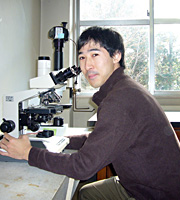Environmental problems such as global warming, acid rain, and ozone depletion are becoming increasingly serious worldwide. In order to alleviate these problems, the development of biomass that has a minimal influence on the environment has recently attracted interest as a resource that can replace fossil fuels, such as oil and coal. Wood biomass derived from forests constitutes a large part of the biomass on the earth, and wood is also the most abundant source of cellulose fibers. Therefore, the sustainable use and reproduction of wood biomass as fuel, fiber, and timber for buildings are necessary for the coexistence of human life with environmental preservation. Based on this background, the goal of this study is to elucidate the mechanisms controlling wood formation and wood properties in trees and to use this information to promote the effective use of wood materials. The fundamental constituent of the wood in a tree is the highly developed cell wall formed by xylem cells. It has been postulated that the properties of wood are closely associated with the structure of wood tissues, the properties of cell walls, and the mechanisms of cell wall formation. In addition, wood formation is strongly influenced by environmental factors, such as water, light, chemical matter, and physical forces. I have been studying the mechanisms of xylem cell wall formation and responses to the environment, as well as the effects of environmental factors on wood formation and wood properties in trees using various approaches involving the fields of histology, physiology, physics, and molecular biology. These studies should contribute to the development of trees that grow rapidly, with excellent wood quality and a good tolerance of environmental stresses, to produce usable wood materials that will help to improving and preserving the environment.
Profile

Yoshihiro HOSOO
- Research Area:
- Wood science
- Keywords:
- Trees, Wood formation, Response to environments, Xylem cell wall, Wood properties
- Contact:
- 8304 Minami-Minowa-mura, Kamiina-gun, Nagano-ken
Japan 399-4598
E-mail: hosoo[at-mark]shinshu-.ac.jp
Employment Experience:
Apr. 2004-Mar. 2007:
Assistant, Academic Assembly Institute of Science and
Technology, Niigata University
Apr. 2007-Oct. 2007:
Assistant Professor, Academic Assembly Institute of
Science and Technology, Niigata University
Nov. 2007-Present:
Tenure-track Assistant Professor, Fiber-Nanotech Young
Researcher Empowerment Center, Shinshu University
Education:
Apr. 1995-Mar. 1999
School of Agricultural Sciences, Nagoya University
Bachelor of Agriculture in Applied Biological Sciences [March 25, 1999]
Bachelor of Agriculture in Applied Biological Sciences [March 25, 1999]
Apr. 1999-Mar. 2001
Master's program in Graduate School of Bioagricultural Sciences, Nagoya University
Master of Agriculture in Biosphere Resources Science [March 25, 2001]
Apr. 2001-Mar. 2004
Doctoral program in Graduate School of Bioagricultural Sciences, Nagoya University
Doctor of Agriculture (Ph.D.) in Biosphere Resources Science [March 25, 2004]
Selected Publications:
- Hosoo, Y., Yoshida, M., Yamamoto, H. “Effect of light intensity on diurnal differences in the supply of cell wall components to the innermost surface of developing S2layers of tracheids in Cryptomeria japonica.” J. Wood Sci, in press
- Ueuma, H., Yoshii, E., Hosoo, Y., Taira, H. “Cytological study of a male-sterile Cryptomeria japonica that does not release microspores from tetrads.” J. For. Res., 14, 123-126 (2009)
- Baba K, Park YW, Kaku T, Kaida R, Takeuchi M, Yoshida M, Hosoo Y, Ojio Y, Okuyama T, Taniguchi T, Ohmiya Y, Kondo T, Shani Z, Shoseyov O, Awano T, Serada S, Norioka N, Norioka S, Hayashi T “Xyloglucan for generating tensile stress to bend tree stem.” Mol. Plant, 2, 893-903 (2009)
- Hosoo, Y. “Development of pollen and female gametophytes in Cryptomeria japonica.”Int.J. Plant Dev. Biol., 1, 116-121 (2007)
- Hosoo, Y., Imai, T., Yoshida, M. “Diurnal differences in the supply of glucomannans and xylans to the innermost surface of cell walls at various developmental stages from cambium to mature xylem in Cryptomeria japonica.” Protoplasma, 229, 11-19 (2006)
- Hosoo, Y., Yoshii, E., Negishi, K., Taira, H.“A histological comparison of the development of pollen and female gametophytes in fertile and sterile Cryptomeria japonica.” Sex. Plant Reprod., 18, 81-89 (2005)
- Hosoo, Y., Yoshida, M., Imai, T., Okuyama, T. “Diurnal differences in the innermost surface of the S2 layer in differentiating tracheids of Cryptomeria japonica corresponding to a light-dark cycle.” Holzforschung, 57, 567-573 (2003)
- Mäser, P., Hosoo, Y., Goshima, S., Horie, T., Eckelman, B., Yamada, K., Yoshida, K., Bakker, E.P., Shinmyo, A., Oiki, S., Schroeder, J.I., Uozumi, N. “Glycine residues in potassium channel-like selectivity filters determine potassium selectivity in four-loop-per subunit HKT transporters from plants.” Proc. Natl. Acad. Sci. USA, 99, 6428-6433 (2002)
- Hosoo, Y., Yoshida, M., Imai, T., Okuyama, T. “Diurnal difference in the amount of immunogold-labeled glucomannans detected with field emission scanning electron microscopy at the innermost surface of developing secondary walls of differentiating conifer tracheids.” Planta, 215, 1006-1012 (2002)
Research Statement
My goal:
I am planning various studies of trees and their wood biomass, which constitutes the most abundant biological resource on earth. Through this research I would like to contribute to establishing a society with an environmentally sound material cycle that preserves the environment. As part of my research, I actively accept challenges in fields where I am inexperienced, as well as in my current fields of specialization, and would like to broaden my perspective as a researcher. In addition, although I put a lot of my energy into research, I also have an important focus on education, and put a lot of effort into producing skilled and talented scientists. I would like to become a teacher revered by students in the future.